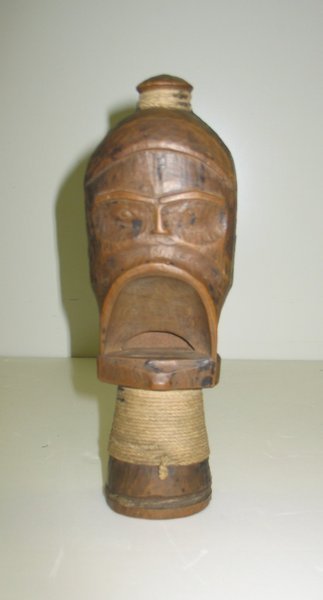Hamatsa Whistle Item Number: 05.588.7351 from the Brooklyn Museum


Description
The whistle is in the form of a human face with an open mouth and the instrument is likely to have been used during the Hamatsa initiation ceremony. Cotton cord is wrapped around the "neck."
Credit Line
Museum Expedition 1905, Museum Collection Fund
Label
Whistles are generally used in indigenous cultures of the Americas to announce the presence of supernatural forces. In the Hamatsa ceremony, young male initiates who behave like wild cannibals as part of their initiation go through a process of four ceremonial cycles that calm and socialize them until they are accepted into society. During the fourth and final section, they reenact the unruly cannibal behavior of Baxbakwalanuksiwae (Man Eater at the End of the World). The wild Hamatsa dancer is brought inside the ceremonial house while whistles such as this one, representing the Man Eater’s many mouths, are blown.
Los silbatos se usan generalmente en las culturas indígenas de las Américas para anunciar la presencia de fuerzas sobrenaturales. En la ceremonia Hamatsa, iniciados jóvenes que se comportan como caníbales salvajes como parte de su iniciación, atraviesan un proceso de cuatro ciclos ceremoniales que los calman y socializan hasta que son aceptados en sociedad. Durante la cuarta sección, ellos reinterpretan la conducta caníbal descontrolada de Baxbakwalanuksiwae (Comedor de Hombres en el Fin del Mundo). El bailarín Hamatsa salvaje es llevado al interior de la casa ceremonial mientras silbatos como éste, representando las muchas bocas del Comedor de Hombres, son soplados.
Item History
- Made between 1800 and 1899
What
- Name
- Hamatsa Whistle
- Identification Number
- 05.588.7351
- Type of Item
- hamatsa and whistle
- Material
- cedar wood, cotton cord, resin and pigment
- Overall
- length 8.6875 in, width 2.75 in
Who
- Culture
- Gwa'sala Kwakwaka'wakw
Where
- Holding Institution
- Brooklyn Museum
When
- Creation Date
- between 1800 and 1899
Other
- Location
- Arts of the Americas Galleries, 5th Floor
- Classification
- Accessory